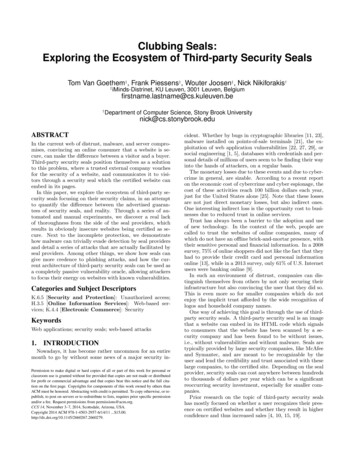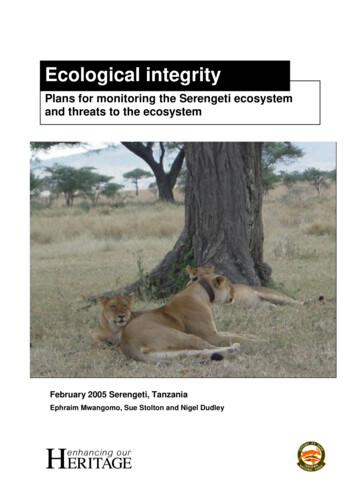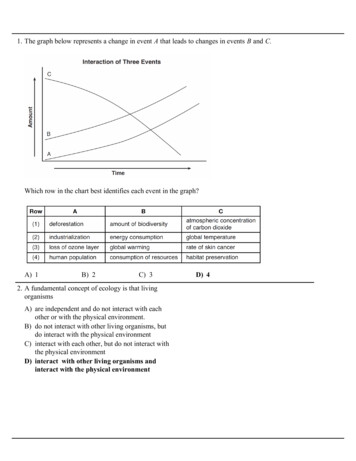
Transcription
Clubbing Seals:Exploring the Ecosystem of Third-party Security SealsTom Van Goethem‡ , Frank Piessens‡ , Wouter Joosen‡ , Nick Nikiforakis†‡iMinds-Distrinet, KU Leuven, 3001 Leuven, ent of Computer Science, Stony Brook Universitynick@cs.stonybrook.eduABSTRACTIn the current web of distrust, malware, and server compromises, convincing an online consumer that a website is secure, can make the difference between a visitor and a buyer.Third-party security seals position themselves as a solutionto this problem, where a trusted external company vouchesfor the security of a website, and communicates it to visitors through a security seal which the certified website canembed in its pages.In this paper, we explore the ecosystem of third-party security seals focusing on their security claims, in an attemptto quantify the difference between the advertised guarantees of security seals, and reality. Through a series of automated and manual experiments, we discover a real lackof thoroughness from the side of the seal providers, whichresults in obviously insecure websites being certified as secure. Next to the incomplete protection, we demonstratehow malware can trivially evade detection by seal providersand detail a series of attacks that are actually facilitated byseal providers. Among other things, we show how seals cangive more credence to phishing attacks, and how the current architecture of third-party security seals can be used asa completely passive vulnerability oracle, allowing attackersto focus their energy on websites with known vulnerabilities.Categories and Subject DescriptorsK.6.5 [Security and Protection]: Unauthorized access;H.3.5 [Online Information Services]: Web-based services; K.4.4 [Electronic Commerce]: SecurityKeywordsWeb applications; security seals; web-based attacks1.INTRODUCTIONNowadays, it has become rather uncommon for an entiremonth to go by without some news of a major security inPermission to make digital or hard copies of all or part of this work for personal orclassroom use is granted without fee provided that copies are not made or distributedfor profit or commercial advantage and that copies bear this notice and the full citation on the first page. Copyrights for components of this work owned by others thanACM must be honored. Abstracting with credit is permitted. To copy otherwise, or republish, to post on servers or to redistribute to lists, requires prior specific permissionand/or a fee. Request permissions from permissions@acm.org.CCS’14, November 3–7, 2014, Scottsdale, Arizona, USA.Copyright 2014 ACM 978-1-4503-2957-6/14/11 . dent. Whether by bugs in cryptographic libraries [11, 23],malware installed on points-of-sale terminals [21], the exploitation of web application vulnerabilities [22, 27, 29], orsocial engineering [1, 5], databases with credentials and personal details of millions of users seem to be finding their wayinto the hands of attackers, on a regular basis.The monetary losses due to these events and due to cybercrime in general, are sizable. According to a recent reporton the economic cost of cybercrime and cyber espionage, thecost of these activities reach 100 billion dollars each year,just for the United States alone [25]. Note that these lossesare not just direct monetary losses, but also indirect ones.One interesting indirect loss is the opportunity cost to businesses due to reduced trust in online services.Trust has always been a barrier to the adoption and useof new technology. In the context of the web, people arecalled to trust the websites of online companies, many ofwhich do not have an offline brick-and-mortar presence, withtheir sensitive personal and financial information. In a 2008survey, 75% of online shoppers did not like the fact that theyhad to provide their credit card and personal informationonline [13], while in a 2013 survey, only 61% of U.S. Internetusers were banking online [9].In such an environment of distrust, companies can distinguish themselves from others by not only securing theirinfrastructure but also convincing the user that they did so.This is even more so for smaller companies which do notenjoy the implicit trust afforded by the wide recognition oflogos and household company names.One way of achieving this goal is through the use of thirdparty security seals. A third-party security seal is an imagethat a website can embed in its HTML code which signalsto consumers that the website has been scanned by a security company and has been found to be without issues,i.e., without vulnerabilities and without malware. Seals aretypically provided by large security companies, like McAfeeand Symantec, and are meant to be recognizable by theuser and lend the credibility and trust associated with theselarge companies, to the certified site. Depending on the sealprovider, security seals can cost anywhere between hundredsto thousands of dollars per year which can be a significantreoccurring security investment, especially for smaller companies.Prior research on the topic of third-party security sealshas mostly focused on whether a user recognizes their presence on certified websites and whether they result in higherconfidence and thus increased sales [4, 10, 15, 19].
In this paper, we perform a three-pronged analysis ofthird-party security seal providers. Instead of measuringwhether users trust security seals, we want to know whetherthese seals should be trusted in the first place. First, wecompile a list of ten popular seal providers and analyze theircertification methods. We discover that, among others, thesecurity checking of seal-using websites is done almost entirely in a black-box fashion where the seal providers try alist of automated attacks on their clients. By designing anddeploying a known vulnerable web application, we witnessthe inaccuracy and haphazardness of these scanners, withthe best one detecting less than half of the known vulnerabilities.Second, we turn our attention to existing businesses thatuse third-party security seals, discovering more than 8,000websites certified to be secure by the studied seal providers.By gathering and comparing features that are telling of awebsite’s security hygiene, e.g., the use of HttpOnly cookiesand Anti-CSRF tokens in HTML forms, we show that sealusing websites are not more prudent than other websites ofan equivalent nature and popularity. Moreover, by obtaining explicit permission for a manual penetration test on nineseal-using websites, we demonstrate how a moderately motivated attacker can discover high-risk vulnerabilities in mostcertified websites, in less than one working day.Finally, taking into account the workings of seal providers,we detail a series of attacks on websites that are actually facilitated by the use of third-party security seals. Amongothers, we describe the architecture of a completely passivevulnerability oracle that allows an attacker to discover easilyexploitable websites by monitoring the appearance and disappearance of third-party security seals on seal-using websites.Our main contributions are: We perform the first study of third-party security sealsthat tests the claimed security guarantees, exposing alack of thoroughness and sophistication We show that seal-certified websites do not have different security practices when compared to other equivalent non-seal-using websites We demonstrate that even moderately motivated attackers have no problem finding critical vulnerabilitiesin websites that are certified to be secure We describe how attackers can abuse third-party security seals proposing, among others, a completely passive vulnerability oracle that takes advantage of theway seal providers react when one of their clients hasbeen detected as vulnerable2.SECURITY SEALSIn this section, we describe the general workings of thirdparty security seals and list the ten seal providers that weanalyzed, together with their features and deviations fromthe generic model of a third-party security seal.2.1General ArchitectureIn general, third-party security seals follow the architecture shown in Figure 1 which is comprised of two distinctcomponents. We arrived at this architecture through theanalysis of all ten investigated providers, and the recordingof common features.Figure 1: High-level view of the architecture anddelivery of third-party security sealsFirst, if seal providers are to give meaningful security certifications to other websites, they must have a way to assessthe security stance of those websites. This is done throughthe use of an automated scanner which periodically checksthe websites of their clients for the presence of security issues, usually involving vulnerabilities and, in some cases,malware. While the exact scanning frequency depends oneach seal provider and the version of the seal a customerhas bought, the scans are usually repeated either on a dailyor a weekly basis. The clients of seal providers are given access to a web-based “control panel” where they can inspectthe findings of the latest security scan. If the scan discoveredvulnerabilities, the client is given a description of the vulnerability, its exact location and nature (e.g. reflected XSSfound on parameter page of index.php), and some genericguidance for its remediation, usually in the form of linkstowards whitepapers and other security resources. When avulnerability is discovered, the owners of certified websitesare typically given a “grace period” of a few days which theycan use to correct the discovered vulnerability before it affects their certification, i.e., the visual component displayedon their website.The second component of a seal-provider is the seal itself.When a website owner subscribes her website for a thirdparty security seal, she is given a snippet of HTML code (orJavaScript code which creates an HTML snippet) which sheis instructed to place in her page, at the position where shewants the third-party seal to appear. The general format ofseal snippets is as follows: a href " https :// seal - provider . com / info ?client example . com " img src " https :// seal - provider . com / shield ?client example . com "/ /a This snippet always involves an HTML image tag whichdynamically requests an image from the web server of theseal provider. If a website is found to be secure, the serverwill respond with an image of a seal, as shown in Figure 1,which typically includes the logo of the seal provider andis meant to be recognizable by the visitors of the seal-usingwebsite and lend it the credibility associated with the sealprovider. Usually, the image is wrapped in an anchor tag
#Clients3,9803,02946345928111810968484NameNorton SecuredMcAfee infoilSecurityYearly Cost 995 300 697 120 00 360 100 495 2,295 333–0235NATable 1: Overview of evaluated seal providers and their featureswhich is clickable, leads to the domain of the seal provider,and shows the visitor of a certified website more informationabout the seal and the seal provider, e.g., the coverage of thescan that produced the seal, and the day of the last scan.Apart from providing more information, this linked pagecreates an obstacle for website owners who wish to createthe illusion of being certified, e.g., by showing a fake securityseal on their website, possibly scraped by the website of aseal provider’s paying client. Since the extra informationis provided in a page under the seal-provider’s domain, anon-paying user cannot mimic that part of the certification.Interestingly, for the majority of seal providers, when avulnerability is discovered and the certified website fails tocorrect it within its allotted grace period, the security sealmerely becomes invisible. That is, even when a website isvulnerable, a visitor of that website will never see a “negative” security seal. The only way that a visitor can discoverthis fact is by the examination of the HTML source code ofa page and the discovery of the aforementioned HTML snippet – a task well out of reach of common users of the web.As such, the vast majority of web users are not able to distinguish between a website that does not use a third-partysecurity seal, and one that does but is vulnerable.2.2Seal ProvidersTo discover third-party seal providers, we searched in apopular search engine for phrases such as “site security seal”and “site safety seal”. For each result, we manually examinedthe website of each seal vendor to ensure that the seal coverage included the detection of vulnerabilities, as opposedto other types of seals that verify a site’s identity and theproper use of SSL. Due to the extensive labor involved withthe evaluation of each seal provider and its clients, we limited ourselves to ten providers of security seals.Table 1 lists the ten investigated third-party security sealproviders ordered by the number of their clients that wecould discover (we describe the process of client discoveryin Section 3). One can see that the services vary greatly interms of popularity as well as in terms of cost. Interestingly,there seems to be no correlation between the popularity ofa seal provider and the price of seal. Since the two, by far,most popular seal providers are also two large, recognizableantivirus companies, it is likely that the popularity of sealproviders is related more to brand recognition and less toother factors, such as price and word-of-mouth.Five out of the ten seal providers support malware scanning in addition to vulnerability scanning, yet only one provides the option of scanning the server for malware over theFTP protocol. As such, the other services can only discovermalware on the indexable pages and directories of a website.Only two out of the ten investigated services have the optionof server authentication, i.e., scanning the part of a websitethat is behind a registration wall. In these two cases, websiteowners can give the credentials of a user to the seal providerand the location of the login page. This means that the vulnerability scanners of the majority of seal providers will notbe able to find vulnerabilities and malware that reside onthe authenticated part of a website.The investigated seal providers exhibit varied behaviorwhen it comes to how they react in the presence of a discovered vulnerability. The majority of seal providers returns aninvisible image when the client fails to mitigate the vulnerability within the grace period. However, there are two typesof deviation from this behavior: the Norton Secured sealwill always be shown, even when vulnerabilities were found,and similarly, for SecurityMetrics and TinfoilSecurity, theseal will also remain visible, but the status page on the sealprovider website will no longer show that there is a passingcertification.Finally, we would like to stress that although security sealshave been around for more than a decade, it is still a market that is actively being developed. During the course ofour research, McAfee and Godaddy rebranded their securityseal products. The McAfee SECURE seal, which previouslyoffered both a malware scan and vulnerability analysis as asingle package, was split and now only offers a security sealfor passing the malware scan. In our research, we evaluatedthe combination of the malware scan and vulnerability scan,as was originally offered. WebsiteProtection, a GoDaddyproduct, was rebranded as SiteLock, which most likely reflects a change in the third-party that GoDaddy relies onfor their security seal product. As in the case of the McAfeesecurity seal, our research is mainly based on the originalproduct that was offered by GoDaddy.3.ADOPTIONAs explained in Section 2.1, when website owners subscribe their websites to seal providers, they are given a smallHTML snippet that they have to include in their websites.This snippet is responsible for fetching and displaying the security seal to the visitors of the certified site. In this section,
1200800400Number of sites00e 002e 054e 056e 058e 051e 06Alexa inancial ServicesHealthComputers / InternetBusiness / EconomyShoppingFigure 2: Distribution of seal-using websites in theAlexa top 1 million websites0500 10002000Number of siteswe take advantage of this snippet in order to automaticallydetect seal-using websites, in an effort to understand thenature of websites that choose to certify themselves usingsecurity seals.More specifically, using a crawler based on PhantomJS,we performed a shallow crawl of the top 1 million websitesaccording to Alexa, searching for inclusions of specific remote images and anchor tags from each of the ten studiedseal providers. To account for seal-using websites that arenot part of the top 1 million Alexa websites, we used someadvanced search features of Google’s search engine, which webased on the same HTML snippets. For example, the following search query site:scanverify.com/siteverify.php returns a list of websites using seals by ScanVerify. Using theseprocesses we were able to discover a total of 8,302 seal-usingwebsites.From the 8,302 websites, 73.64% was part of Alexa’s top 1million websites ranking. Figure 2 shows the distribution ofthese websites across the ranks of Alexa. The distributionis right-skewed where the usage of third-party security sealsdecreases together with the ranking. Our findings indicatethat websites that are already popular, still choose to useseals as a mechanism of convincing users that they do takesecurity seriously.To identify the nature of these 8,302 websites, we usedTrendMicro’s public website categorization database [32].Figure 3 shows the ten most popular categories of seal-usingwebsites. As one can see, the “Shopping” category is by farthe most popular with 35.74% of the entire dataset beingcategorized as such. Given the motivation for using thirdparty security seals that the seal providers themselves use,this result makes intuitive sense. Security seals are advertised as capable of increasing a user’s trust for any givenwebsite which, in turn, translates to increased sales. As amatter of fact, most seal providers’ advertising campaignsheavily rely on testimonials where existing clients claim tohave seen a significant increase of sales (in the range of 5%20%) after the adoption of their security seal. As such, shopping websites are the primary target audience for buyingsecurity seals from seal providers. This result is also interesting from a security point of view. Websites belonging toe-shops are highly dynamic in nature, with frontends andbackends, and various e-commerce modules. As such, theirextended attack surface, together with the prospect of exfiltrating financial and personal data upon compromise, makeshopping websites more attractive targets over other categories of websites, such as blogs and news websites.Figure 3: Ten most popular categories of seal-usingwebsites4.SECURITY EVALUATIONSeal vendors claim that a security seal increases the trustworthiness of a certified website and leads to increased sales.In this section, we seek to understand whether a user’s trustshould increase in the presence of a third-party security seal.In order to assess the thoroughness of service providedby the ten investigated seal providers, we conducted thefollowing three experiments. First we compare the security practices of seal-using websites to other equivalent websites which do not make use of seals. Second, by obtainingpermission for penetration testing, we investigate whethera moderately interested attacker would be able to find avulnerability in a supposedly secure website, i.e., a websitebearing a security seal. Third, we set up a webshop includingmultiple vulnerabilities, in order to understand which vulnerabilities are discoverable by seal providers and how easyit is for a vulnerable site to obtain a clean bill of health.4.1Comparison to non-certified websitesWhen a website uses a third-party security seal, it mayseem reasonable to assume that the administrators of thatwebsite are, in general, interested in the security of their siteand are thus taking all the necessary precautions to securetheir services and protect their users.In this section, we test this assumption by comparing theadoption of popular security mechanisms by seal-using websites against the adoption of the same mechanisms by equivalent websites which do not use third-party seals. Next tosecurity mechanisms we also test for issues that can be detected in a non-intrusive way.Comparison DatasetTo have meaningful comparisons between seal-certified andnon-certified websites, the second set of websites must besimilar to the first one, in all matters except for the adoption of a security seal. While this is virtually impossibleto establish from the client-side without full knowledge ofan application’s codebase and environment, we provide anapproximate solution as follows.For every seal-utilizing website, we attempt to identifyanother site of the same category within ten places in theAlexa ranking of the top 1 million websites. If, for instance,buyfromhome.com is a seal-utilizing e-shop ranked at the
100th place, we search for another e-shop site either tenranks above, or ten ranks below the 100th place. The direction of our search is decided probabilistically using theprobability distribution of a fair coin. As before, the categories of each site are determined using TrendMicro’s publicwebsite categorization engine [32].Using this process we were able to match 2,238 seal-usingwebsites to 2,238 other websites of equivalent rank and category that do not use third-party security seals.Security IndicatorsIn recent years, as a response to a continuous battery ofexploitations of web application vulnerabilities, browser vendors and the research community introduced a series of clientside security mechanisms that are today available in the vastmajority of modern browsers. These client-side mechanismsare usually guided by server-side policies, where the webserver expresses its security desires through HTTP headersand the browsers are responsible for enforcing them at theside of the user. In addition, web application programmershave come up with various “best practices” that should always be followed, e.g., an anti-CSRF token in all forms.While the presence or absence of such security mechanismsdoes not equate to proof of the presence or absence of exploitable vulnerabilities, they still can be used as indicatorsof the security hygiene of any given website. In addition,these mechanisms can be detected in a completely passivefashion thereby not incurring any unnecessary stress on webapplications. In prior research, Nikiforakis et al. [26] combined some of these indicators in a Quality-of-Maintenancemetric and applied it on servers offering remote JavaScriptlibraries. Vasek and Moore investigated whether certainserver characteristics can be used as risk factors for predicting server compromise [33], and found that HttpOnly cookiescan, for some types of compromise, be negative risk factors,i.e., their presence is correlated more with non-compromisedwebsites rather than compromised ones.For our experiment, we searched for the presence or absence of the following, passively discoverable, security mechanisms and best practices: HTTP Strict Transport Security (HSTS) Secure Cookies HttpOnly Cookies Content Security Policy (CSP) X-Frame-Options (XFO) iframe sandboxing Anti-CSRF Tokens X-Content-Type-Options SSL-stripping Vulnerable FormA brief description of each of these mechanisms can befound in this paper’s Appendix.ResultsFor each of the 4,476 websites, we used a crawler based onPhantomJS to automatically visit a site’s main page andten other pages within the same domain, which were obtained using a shallow crawl. To simplify comparisons, wecounted the present security mechanisms and issues in aSecurity MechanismorIssueHSTSSecure CookiesSSL StrippingX-Frame-OptionsHTTP-Only CookiesCSPAnti-CSRF TokensX-Content-Typeiframe .00)7(0.06)7(0.99)3(0.02)3( 0.01)–(NA)3( 0.01)–(NA)7(0.37)Table 2: Comparison of the discovered issues and security mechanisms between websites with and without seals. Highlighted entries denote the bettervalue, in the statistically significant cases.binary fashion. If, for example, one page of the domainexample.com used an HttpOnly cookie, then we credited theentire example.com domain with that security mechanism.Table 2 shows the percentage of security mechanisms andissues discovered in the seal-utilizing websites and in ourgathered set of equivalent websites. To compare the adoption between our two sets of websites, we conducted a twosided hypothesis test for the comparison of two independentproportions. For each row in Table 2, our null hypothesis(H0 ) was that the true proportion of that mechanism is thesame between the two sets, while the alternative hypothesis (HA ) was that the true proportions of that mechanismfor the two sets are different from each other. The last column of Table 2 shows the results of each hypothesis test,i.e., whether the adoption of each mechanism is different ina statistically significant way, and reports the p-value of thehypothesis test. Following standard practices in hypothesistesting, 0.05 was the cut-off point for the computed p-value,over which the null hypothesis is maintained.As one can see, only one third of the measured proportions were different in a statistically significant way, whilein two out of the three cases, the difference was creditedin favor of the websites without security seals. The lack ofmore significant differences between the adoption of securitymechanisms can be interpreted as a lack of systematic difference between the security hygiene of seal-using websitesand the hygiene of equivalent websites that do not use seals.This, in turn, hints towards the absence of a holistic security strategy by the adopters of third-party security seals.In other words, if the intuitive notion that bad security hygiene is correlated with increased probability of compromiseis true, seal-using websites are not more secure than theirnon-seal equivalents.4.2Penetration TestingSecurity seal providers claim to protect websites by periodically scanning for the presence of thousands of vulnerabilities. One could assume that this would result in thedetection of most easily discoverable vulnerabilities, thusmaking the discovery of a vulnerability by an attacker, along and arduous task.
To test this hypothesis, we contacted 1,000 seal-using websites asking for explicit permission to conduct a manual penetration test. While the vast majority of websites never responded to our request, nine websites granted us permissionto proceed. In order to avoid bias in our experiment we simulated a moderately motivated attacker who only has eighthours (one working day) to find a vulnerability before proceeding to the next target.In our manual penetration test, we evaluated websites forseveral common vulnerabilities, such as SQL injection, crosssite scripting and CSRF, as well as for application-logic attacks. Despite the limited time available for evaluating eachwebsite, we were able to find several severe vulnerabilities,such as XSS and SQL Injection, for seven out of the nineevaluated websites. Additionally, we found HTTP parameter tampering vulnerabilities, as well as application-flowvulnerabilities, in three out of the four webshops that weanalyzed, allowing us to order products and services for arbitrary prices.These results clearly indicate that the hypothesis that attackers with limited resources are unable to find vulnerabilities in sealed websites, is false. In our manual analysis, wecould register on the websites under evaluation, access content that requires authentication, and reason about prices inshopping carts – actions that are not supported by the automated scanners of most seal providers. Besides these generallimitations that render seal providers unable to find vulnerabilities which require a series of coherent actions, we alsofound easily discoverable vulnerabilities, which were missedby the seal providers, in six out of nine websites. Thesevulnerabilities consist of cross-site scripting vulnerabilitieswhere a GET or POST parameter was reflected withoutproper encoding, and even a “textbook” SQL injection.We also want to mention one incident that demonstratesthe haphazardness of the certification of certain seal providers.In one specific case, an e-shop, certified to be secure by athird-party seal provider, gave us an SQL error while contacting them to ask for permission for a manual penetrationtest. When reviewing the case, we realized that we had useda contraction in our message to the website where we inadvertently introduced a single quote, e.g., the phrase “do not”contracted to “don’t”. The SQL error was generated by thatsingle quote in the message body.4.3Vulnerable Webshop ExperimentBeing able to accurately assess the state of security of awebsite, is one of the key requirements of a seal provider,if the seal is to be trusted by consumers. That is, if trivially vulnerable websites can be certified as secure, then thecertification becomes void of meaning. To evaluate the accuracy of the tools used by seal providers to verify a website’ssecurity, we set up a webshop which included a number of severe vulnerabilities. More specifically, we used an outdatedversion of PrestaShop, a popular open source e-commerceapplication, which suffers from a cross-site scripting vulnerability, and expanded the
way seal providers react when one of their clients has been detected as vulnerable 2. SECURITY SEALS In this section, we describe the general workings of third-party security seals and list the ten seal providers that we analyzed, together with their features and deviations from the generic model of a third-party security seal. 2.1 General .










